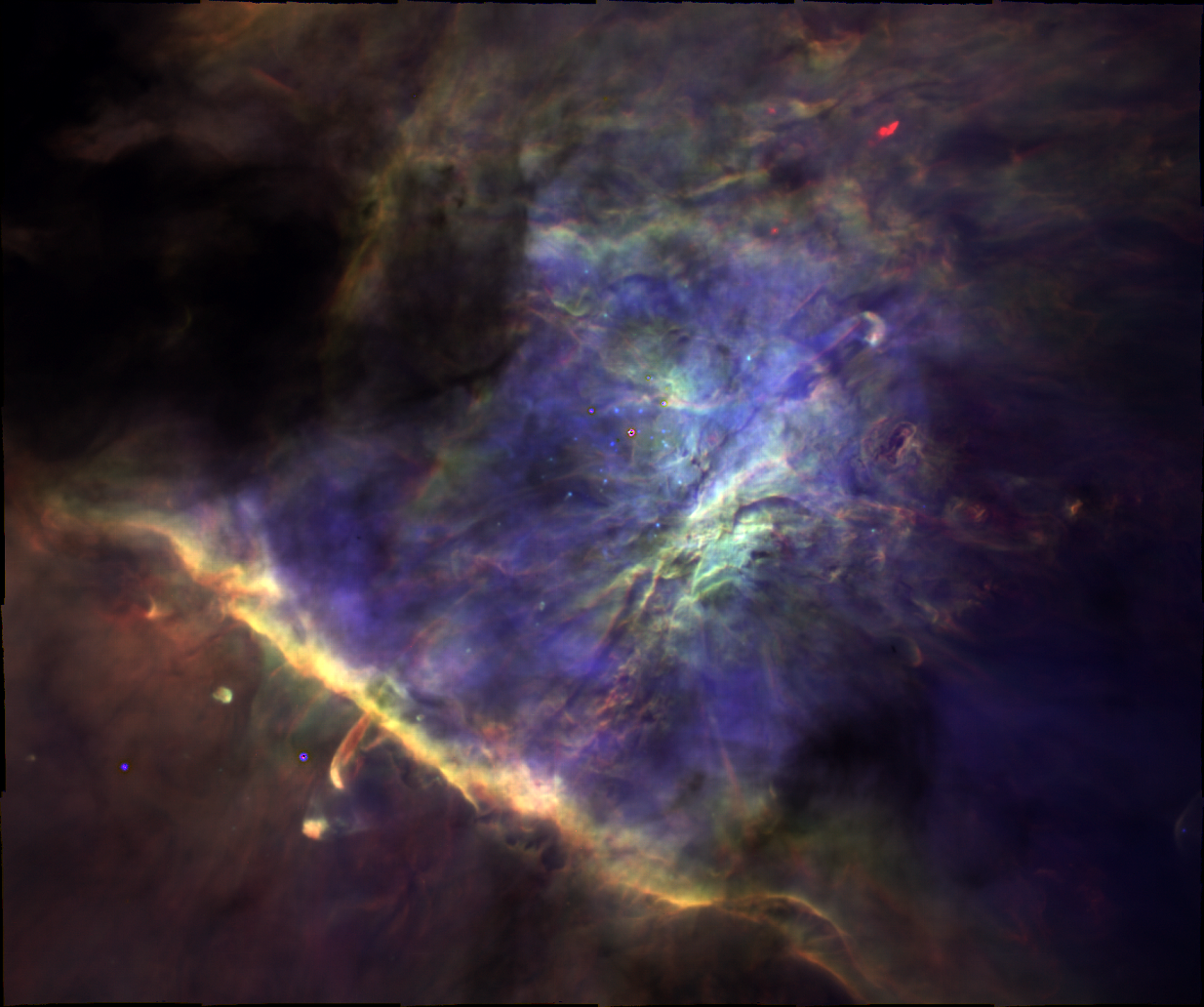Moleculair waterstof (H2) beslaat 99% van het koude dichte gas in sterrenstelsels. Dus het in kaart brengen waar sterren worden geboren betekent in feite het opmeten van H2, dat helaas een sterke kenmerkende signatuur mist bij lage temperaturen. Astronomen van SRON Netherlands Institute for Space Research en de Rijksuniversiteit Groningen hebben nu een emissiesignaal in kaart gebracht van het traceermolecuul waterstoffluoride (HF), op een plek waar het standaard traceermolecuul koolmonoxide afwezig is. Ze zijn de eersten die een kaart van HF produceren voor een regio in het heelal, waarmee ze een nieuw hulpmiddel creëren om indirect H2 in kaart te brengen. Publicatie op 6 november in Astronomy & Astrophysics.

Kriskras door alle sterrenstelsels in ons heelal ontstaan en sterven er sterren. En terwijl het leven op Aarde is gebaseerd op een rijke mengelmoes van allerlei elementen en moleculen, is het koude dichte gas waaruit sterren ontstaan erg monotoon met 99% moleculair waterstof (H2). Dus als je in kaart wilt brengen waar sterren worden geboren, kun je maar beter goed in de vingers hebben hoe je H2 detecteert. Helaas is deze stof moeilijk om te zien door een gebrek aan een sterk karakteristiek signaal bij lage temperaturen—in tegenstelling tot zijn atomaire neef (H) die radiostraling uitzendt op een gemakkelijk te onderscheiden golflengte van 21 cm. Astronomen van SRON Netherlands Institute for Space Research en de Rijksuniversiteit Groningen hebben nu een nieuw hulpmiddel ontdekt om indirect H2 te meten, door waterstoffluoride (HF) in kaart te brengen en de aanwezigheid daarvan te linken aan die van H2.
Waterstoffluoride
Het nieuwe hulpmiddel komt van pas als andere trucjes het laten afweten, bijvoorbeeld in de Orion Bar, tussen de regio’s rond de Orion Trapeziumsterren en de Orion moleculaire wolk. In deze gebieden is koolstof geïoniseerd, wat betekent dat koolstofmonoxide (CO)—doorgaans een betrouwbaar tracermolecuul om H2 te vinden—in dit geval niet werkt als tracer. Floris van der Tak en zijn team waren verrast toen ze een karakteristiek HF-signaal vonden vanuit de Orion Bar, in data van de Herscheltelescoop, omdat astronomen waterstoffluoride tot dusverre alleen als silhouet hadden gedetecteerd: HF dat andere straling absorbeert. Je kunt de aanwezigheid van HF en H2 aan elkaar linken omdat HF wordt geproduceerd in een chemische reactie waarin H2 reageert met atomair fluor (F) om HF te vormen en atomair waterstof (H). Zonder H2 heb je geen HF.
Botsingen
Het team, onder leiding van SRON-promovendus Ümit Kavak, gebruikte hun kaart van HF om een aantal mechanismen te bestuderen waardoor het zijn signaal kan uitzenden. Botsingen van HF-moleculen met elektronen en moleculair waterstof blijkt het hoofdmechanisme te zijn. De botsingen slaan HF-moleculen aan naar een hoger energieniveau, waarna ze terugvallen naar hun grondtoestand onder uitzending van infrarood licht met een karakteristieke golflengte van 1.2 THz.
Publicatie
Ü. Kavak, F. F. S. van der Tak, A. G. G. M. Tielens and R. F. Shipman, ‘Origin of hydrogen fluoride emission in the Orion Bar’, Astronomy & Astrophysics
Astronomers map new emission line to trace most common molecule in the Universe
Molecular hydrogen (H2) makes up 99% of the cold dense gas in galaxies. So mapping where stars are born basically means measuring H2, which lacks a strong characteristic signature at low temperatures. Astronomers from SRON Netherlands Institute for Space Research and the University of Groningen have now mapped an emission signal from the trace molecule hydrogen fluoride (HF), in a place where the standard trace molecule carbon monoxide is absent. They are the first to produce a map of HF for a region in space, creating a new tool to indirectly map H2. Publication in Astronomy & Astrophysics on November 6th.
All across galaxies in our Universe, stars are dying and forming. And while our life on Earth is based on a rich jumble of various elements and molecules, the cold dense gas out of which stars form is pretty monotonous with 99% molecular hydrogen (H2). So if you want to map where stars are born, you’d better have a good grasp on how to detect H2. Unfortunately, this material is hard to observe due to a lack of a strong characteristic signal at low temperatures—unlike its atomic cousin (H) which emits radio waves at an easily distinguishable wavelength of 21 cm. Astronomers from SRON Netherlands Institute for Space Research and the University of Groningen have now discovered a new tool to indirectly measure H2, by mapping hydrogen fluoride (HF) and linking its abundance to that of H2.
Hydrogen fluoride
The new tool comes in handy when other tools fail, for example in the Orion Bar, in between regions around the Orion Trapezium stars and the Orion Molecular Cloud. In these areas carbon is ionized, meaning that carbon monoxide (CO)—usually a reliable trace molecule to find H2—can’t work as a tracer in this case. Floris van der Tak (SRON/RuG) and his team were surprised to find a characteristic HF signal in data from the Herschel telescope coming from the Orion Bar, as astronomers have previously only detected hydrogen fluoride as a silhouette: HF absorbing other radiation. HF and H2 abundance can be linked because HF is produced in a chemical reaction where H2 reacts with atomic fluorine (F) to form HF and atomic hydrogen (H). Without H2 there is no HF.
Collisions
The team, led by SRON PhD student Ümit Kavak, used their map of HF to examine a few mechanisms through which it could emit its signal. Collisions of HF molecules with electrons and molecular hydrogen turns out to be the main mechanism. The collisions excite the HF molecules to a higher energy state, after which they drop to their ground state while emitting infrared light at a characteristic wavelength of 1.2 THz.
Publication
Ü. Kavak, F. F. S. van der Tak, A. G. G. M. Tielens and R. F. Shipman, ‘Origin of hydrogen fluoride emission in the Orion Bar’, Astronomy & Astrophysics


